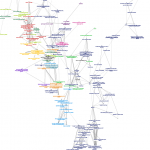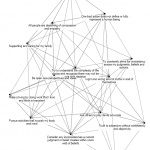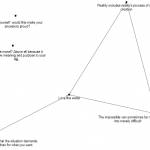LinkedIn has a neat tool called InMaps that I just learned is being retired soon. With click of a button, it creates an interactive visual map of all your LinkedIn connections. It assigns them colors based on their similarities to each other, and you can to label those colored clusters based on the similarities you see.
Back when I first started using LinkedIn, I was pretty gung-ho about making connections. I currently have 2,147 LinkedIn connections, so my LinkedIn map is a little dense with people and the connections between them. Interestingly, my current InMap is more densely concentrated than it was a couple of years ago when I first generated my InMap. There are fewer individuals and nodes that seem distanced from the others.
 It’s a little hard to see who some of the other nodes are that seem to connect multiple sectors, but I could get a sense of who the most connected people are by the size of their dot. Diana Whitney, Matt Leighninger, Thomas Valenti, Larry Schooler, Beth Offenbacker, Jon Ramer, Nancy White, Margaret Herrmann, and Libby and Len Traubman stand out to me as highly connected in LinkedIn.
It’s a little hard to see who some of the other nodes are that seem to connect multiple sectors, but I could get a sense of who the most connected people are by the size of their dot. Diana Whitney, Matt Leighninger, Thomas Valenti, Larry Schooler, Beth Offenbacker, Jon Ramer, Nancy White, Margaret Herrmann, and Libby and Len Traubman stand out to me as highly connected in LinkedIn.
One of the nice features InMaps offers is that it allows you to label your own clusters. If you click around all of the orange or blue dots on your map, it becomes clear that the people assigned to that color have something in common. The image to the right shows how I chose to label my colored clusters.
My connections on LinkedIn, in large part, are NCDD’s connections. Reflecting on Albert-László Barabási’s Linked (a book on the power of networks), I feel pretty encouraged by the denseness and variety of my network map. In Barabási’s chapter “Hubs and Connectors,” he writes:
“Indeed, with links to an unusually large number of nodes, hubs create short paths between any two nodes in the system. Consequently, while the average separation between two randomly selected people on Earth is six, the distance between anybody and a connector is often only one or two.”
I’m curious about what other NCDDers’ InMaps look like, and how you would label your own clusters. To create your own InMap (before it’s too late!), go to http://inmaps.linkedinlabs.com/ (you’ll have to enter your LinkedIn password). Once it has generated your map and you’ve added your labels, click Share and then add the web address of your map in the comments below so others can take a look. The link to your shareable map will look something like mine:
http://inmaps.linkedinlabs.com/share/Sandy_Heierbacher/575702...
Also – I’m very curious about what network mapping tools have worked best for NCDDers? Mapping my own LinkedIn contacts or Facebook contacts is interesting, but NCDD is starting to map the organizations, collaboration, and capacity in our field. What tools would you suggest we learn more about as we embark on this important task? Are there any tools you’ve found particularly useful? What tools have disappointed you?



 The
The 

